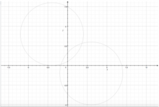Determinare
[math]a[/math]
e [math]b[/math]
in modo che l'iperbole di equazione [math](x^2)/(a^2)-(y^2)/(b^2)=1[/math]
passi per i punti [math]A(-4\sqrt{10};9), B(8;-3\sqrt3)[/math]
. Svolgimento
Dobbiamo verificare per quali valori di[math]a[/math]
e [math]b[/math]
, idue punti appartengono all'iperbole [math]\gamma:=(x^2)/(a^2)-(y^2)/(b^2)=1[/math]
Se [math]A in \gamma => (-4\sqrt{10})^2/(a^2)-(9)^2/(b^2)=1 => (160)/(a^2)-(81)/(b^2)=1[/math]
Se [math]B in \gamma => (8)^2/(a^2)-(-3\sqrt3)^2/{b^2}=1 => (64)/(a^2)-(27)/{b^2}=1[/math]
Mettiamo a sistema le due equazioni e risolviamolo per sostituzione
[math]\egin{cases} (160)/(a^2)-(81)/(b^2)=1 \\ (64)/(a^2)-(27)/(b^2)=1 \ \end{cases}[/math]
; [math]\egin{cases} (160)/(a^2)=(81)/(b^2)+1 \\ (64)/(a^2)-(27)/(b^2)=1 \ \end{cases}[/math]
; [math]\egin{cases} 1/(a^2)=((81)/(b^2)+1)/(160) \\ (64)((81)/(b^2)+1)/(160)-(27)/(b^2)=1 \ \end{cases}[/math]
; [math]\egin{cases} 1/(a^2)=((81)/(b^2)+1)/(160) \\ 2((81)/(b^2)+1)/5-(27)/(b^2)=1 \ \end{cases}[/math]
; [math]\egin{cases} 1/(a^2)=((81)/(b^2)+1)/(160) \\ 2((81)/(b^2)+1) \cdot 1/5-(27)/(b^2)=1 \ \end{cases}[/math]
; [math]\egin{cases} 1/(a^2)=((81)/(b^2)+1)/(160) \\ (162)/(5b^2)-(27)/(b^2)=1-2/5 \ \end{cases}[/math]
; [math]\egin{cases} 1/(a^2)=((81)/(b^2)+1)/(160) \\ ((162)/5-27)(b^2)=3/5 \ \end{cases}[/math]
; [math]\egin{cases} 1/(a^2)=((81)/(b^2)+1)/(160) \\ (27)/5b^2=3/5 \ \end{cases}[/math]
; [math]\egin{cases} 1/(a^2)=((81)/9+1)/(160) \\ b^2=9 \ \end{cases}[/math]
; [math]\egin{cases} 1/(a^2)=(10)/(160)=1/(16) \\ b^2=9 \ \end{cases} => {(a^2=16),(b^2=9):}[/math]
. Pertanto [math]a=4[/math]
e [math]b=3[/math]
.

![Geometria analitica: Un'ellisse di equazione[math]\frac{{x}^{2}}{{a}^{2}}+\frac{{y}^{2}}{{b}^{2}}={1}[/math] passa per P(3,2) ed è tangente in tale punto alla retta con coefficiente angolare [math]-3/8[/math]](https://cdn.skuola.net/shared/thumb/159x141/news_foto/2017/09/geom_anal_e32.jpg)
